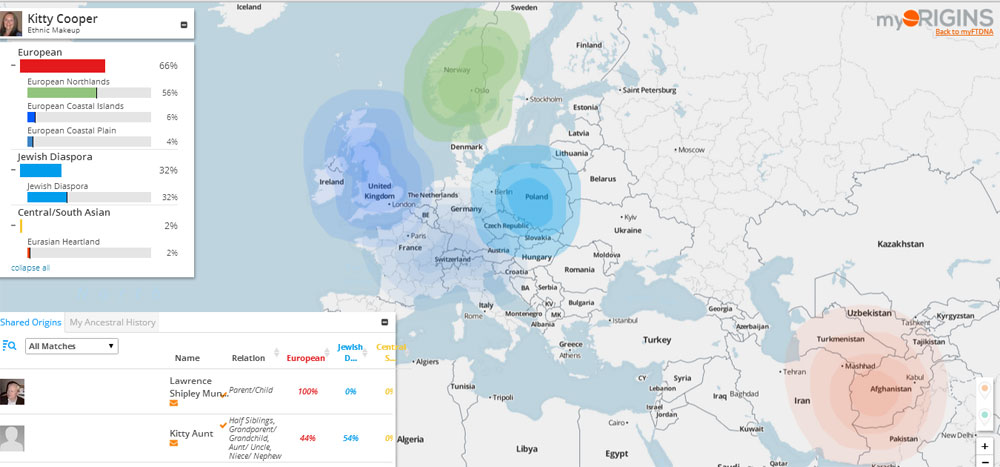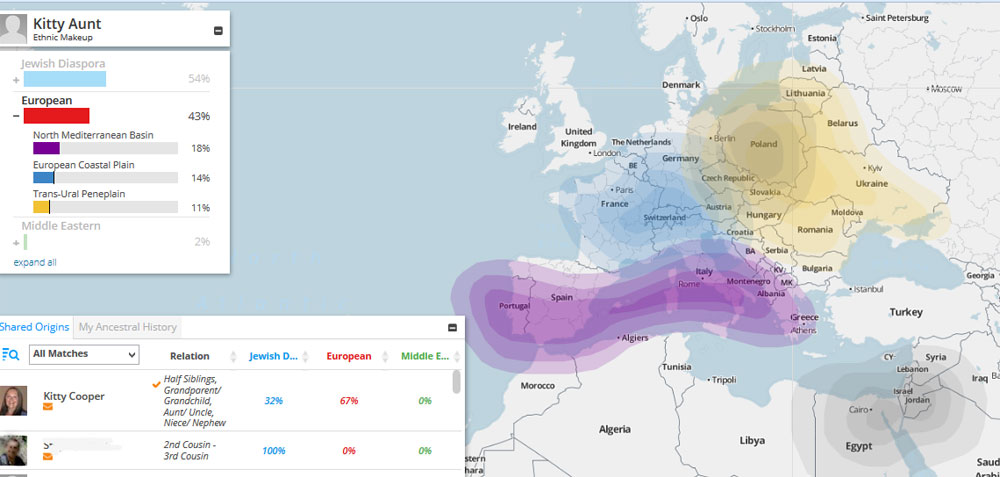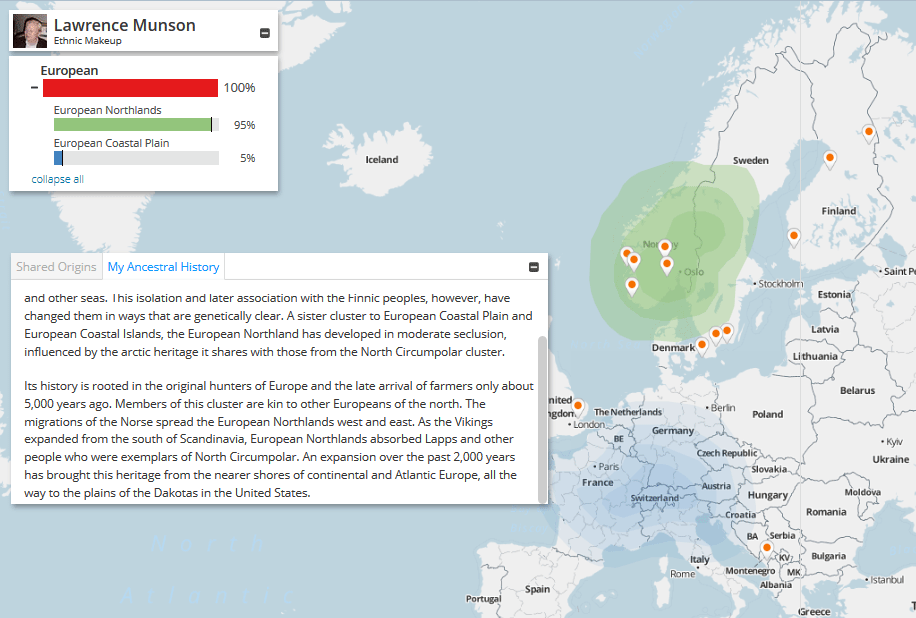Family Tree DNA has come out with a great way of showing your genetic ancestry for the last several thousand years using a clickable feature-filled map called “myOrigins.” It is listed in the submenu under “Family Finder” on the main menu. You have to have done the Family Finder test, or transferred your autosomal data from elsewhere, to have this feature.
Their data shows that DNA has specific signatures in geographic clusters rather than by modern countries, so your origins are shown in terms of those clusters. In my own case, I am half Norwegian from my Dad and half German from my mother where half of that German was Jewish. I know from other testing companies that I got well more than 25% of my jewish grandfather’s DNA, so I was not surprised to see Jewish Diaspora listed at 32% as 23andme says I have 27% Ashkenazi. Here is the myOrigins picture for me from my transferred 23andme data.
The bottom left box shows your relatives’ percentages in your top three clusters. You can click on any relative to show the location on the map for their furthest back maternal and paternal ancestor (if they have entered that information). Clicking the green (maternal) and red (paternal) dots on the far bottom right will put pins on the map for the furthest back maternal and paternal ancestor locations for all your closest matches who have entered that information. Click on a pin to see the person’s name. Click the red or green dots again to get rid of those pins.
To see a little historical explanation of a specific population cluster you have to expand the larger cluster, for example European, in the box on the top left, and then click on a specific cluster like “European Coastal Plain.” Then some information will be displayed in the bottom left box, under the “My Ancestry History” tab.
Here is part of what it says about my Northlands cluster, “The European Northlands centers on the people of Scandinavia. They thought of their homeland as an island because it is relatively isolated from the rest of the world by the Baltic and other seas. This isolation and later association with the Finnic peoples, however, have changed them in ways that are genetically clear. A sister cluster to European Coastal Plain and European Coastal Islands, the European Northland has developed in moderate seclusion, influenced by the arctic heritage it shares with those from the North Circumpolar cluster.” Since I am shown as well more than half Northern, I have to assume some of that came to my German side as well.
To better understand how to use all the features, I did the online seminar about myOrigins which can be found at the ftDNA library of webinars located at https://www.familytreedna.com/learn/ftdna/webinars/. It was easy to sign up for it and download it and then play it in the “Windows Media Player” where it worked perfectly.
An interesting fact was that genetically ftDNA cannot tell a Scot from an Irishman or Englishman; they are all part of the “European Coastal Islands” cluster from a mixture of the Celts, Picts, Vikings, Normans, and French. They describe this cluster as ” typical to the British Isles, especially Ireland. Its reach includes all European Islands from the far north and down south to the Azores Islands off the coast of Spain. The continuous mixing of European populations means that this group is also present in lesser amounts on the mainland.”
One of the important things I learned from the webinar was that Germans fall into two different clusters. Both the “European Coastal Plain” which radiates out from France on the above map and the “Trans Ural Peneplain” which is what we might call Slavic. This latter group is more in the east of Germany. So let’s look at my maternal aunt who is 100% German, half of which is Jewish.
She has several population clusters that did not make it from my late mother to me and she does not have my Iranian 2%. We were expecting the “Trans Ural Peneplain” from the German side, but were surprised by the high proportion of “North Mediterranean Basin.” But then again we really do not know where our Bavarian ancestors may have migrated from in the last few thousands of years. Some of them were South of the Danube, so they would have been part of the Roman Empire. The little bit of Middle East was perhaps an expected part of the Ashkenazi heritage but surprisingly more than half of her DNA heritage is Jewish. So did her Bavarian Catholic mother have some Ashkenazi on her tree too?
My father is 100% Southern Norwegian with one 4th g-grandfather who was German. We have an extensive paper trail for his ancestors going back to the 1600s on most lines and much much further back many lines. His myOrigins picture shows exactly that mixture. We added the paternal pins to this image and have the rest of the Northlands description in the bottom box.
Notice that several of his matches have a furthest back paternal ancestor in Finland. We have not yet found a Finnish ancestor but 23andme claims that parts of his chromosomes 4 and 10 are Finnish. However he is not listed here as having any “North Circumpolar” which is the Finnish cluster.
So while myOrigins seems fairly accurate for our family, I have seen some posts where people found surprises, like a lot of Northlands in British descended folk. Doesn’t seem so surprising to me as Vikings settled in York and many parts of England. Still it seems that the sample sizes ftDNA used are not all that large. Here is a slide from the webinar showing the sizes of the reference populations:
Soon there will be a white paper describing the algorithms for these conclusions on the Family Tree DNA website. I will post that URL in the comments here when it becomes available.




“Bavarian ancestors”
hey,
just want to tell you i am always surprised by the large % of ‘southern european’ type ancestry bavarians have. austrians too (though they have more ‘eastern’ stuff.
Good overview, Kitty. I was wondering if others thought as I did that the samples were small. My profile went from 100% Orcadian to a five-part mix of European with a smidgen of Anatolia & Caucasus. My mother was 100% Scots-Irish but my dad’s ancestors were spread out over England and Wales – so who knows where those parts come from? It makes a pretty map, but I’ll never know. 😉
The white paper describing the methodology used is now posted at
https://www.familytreedna.com/learn/family-finder-pages/myorigins-methodology/
It is clear from reading the white paper that these population signatures are thousands of years old so I have corrected this post. The paper also has many more details about each population group
I’m hoping you can help me, before the change at Family DNA, I was 93% Orcadian and 7% Jewish. Now I’m European Coastal 35%, North Mediterranean Basin 30%, European Northlands 28% and Trans-Ural Peneplain 7%. Trans-Ural Peneplain is that where the Jewish part went?
Ann did you expect some Jewish? Or was this news? If it was news then yes it could be North Mediterranean or Trans-Ural now. But these estimates are not all that accurate yet. Have you uploaded your results to GEDmatch? The admixture tools there are better I think. I intend to blog about the different calculators soon
Yes was expecting some Jewish. Trying to get GEDMatch to work on my computer. Had problems with getting everything uploaded last night.
Have another question, do these tests show Native American? We did the tests for my husband to rule out or in the rumors in his family of Native American. Genealogy research has not proved the rumors.
Ann, yes these tests will show the Native American but again you may need to use the admix calculators at GEDmatch. It has had a few hiccups recently and after you upload you have to wait for it to process your data
If the Native American ancestor was from 7 generations or more ago and was the only Native American ancestor then the Gedmatch calculators won’t pick it up. I have seen where one person has Native American ancestry and the spouse does not. The children inherit close to 50% of the Native American ancestry of the parent that has it. If that happens over and over again for 7 generations or more the amount is diluted by so much the it is almost undetectable in the calculators.
If my husband does have Native American heritage it must be pretty diluted. We didn’t really find much to go on.
2 previous DNA testing showed 2% African and 2% Asian. “My Origins” is now saying 100% European. Do not understand.
Phyllis each company has different databases that they use for this determination. Family Tree DNA is better than it was but is still not all that accurate. Plus anything only 2% may show at one company but not another. These are likely quite far back in time as well with that low a percentage.
Try the calculators at GEDmatch.com as they are much more accurate. I like the Eurogenes 12 myself